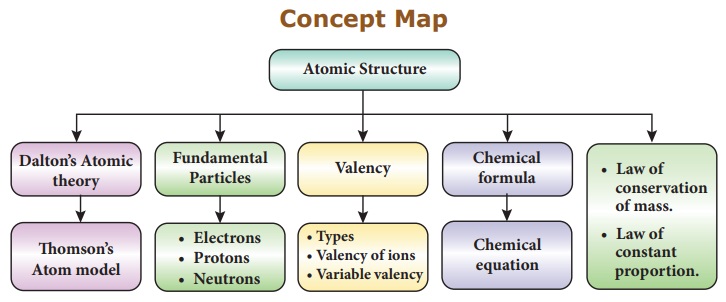Chapter 12 | 8th Science - Atomic Structure | 8th Science : Chapter 12 : Atomic Structure
Chapter: 8th Science : Chapter 12 : Atomic Structure
Atomic Structure
UNIT 12
ATOMIC STRUCTURE

Learning Objectives
After the completion
of this lesson, students will be able to:
ŌĆó understand the
advantages and limitations of DaltonŌĆÖs atomic theory.
ŌĆó distinguish the
fundamental particles and their properties
ŌĆó get an idea about
ThomsonŌĆÖs atom model and its limitations
ŌĆó calculate the
valency of different elements.
ŌĆó write the chemical
formula and molecular formula of compounds.
ŌĆó balance the chemical
equations.
ŌĆó state the laws of
chemical combinations.

Introduction
Every
substance in our surrounding is made up of unique elements. There are 118
elements identified worldwide so far. Out of these elements, 92 elements occur
in the nature and the remaining elements are synthesised in the laboratories. Copper, Iron, Gold and Silver are some of the
elements found in the nature. Elements like Technetium, Promethium, Neptunium and Plutonium are
synthesised in the labaratories. Each element is made up of similar, minute particles
called atoms. For example, the element gold is made up of gold atoms which
determine its characteristics. The word atom is derived from the Greek word atomos. Tomos means smallest divisible particle and atomas means smallest
indivisible particle. Ancient Greek philosophers
like Democritus, have spoken about atoms. Evenour Tamil poet Avvaiyar has
mentioned about atoms in her poem
while describing Thirukkural (Ó«ģÓ«ŻÓ»üÓ«ĄÓ»łÓ«żÓ»Ź Ó«żÓ»üÓ«│Ó»łÓ«żÓ»ŹÓ«żÓ»ü Ó«ÅÓ«┤Ó»Ź Ó«ĢÓ«¤Ó«▓Ó»łÓ«¬Ó»ŹÓ«¬Ó»üÓ«ĢÓ«¤Ó»ŹÓ«¤Ó«┐Ó«ĢÓ»Ź Ó«ĢÓ»üÓ«▒Ó»üÓ«ĢÓ«żÓ»ŹÓ«żÓ«░Ó«┐Ó«żÓ»ŹÓ«ż Ó«ĢÓ»üÓ«▒Ó«│Ó»Ź). But, none of them have scientific
base. The first scientific theory about atom wasgiven by John Dalton. Followed by
him, J.J.Thomson and Rutherford have
given theirtheory about atom. In this lesson, we will studyhow atomic theories
evolved at different times.We will also study about valency, molecularformula,
rules for naming chemical compounds and
balancing chemical equations.
Related Topics